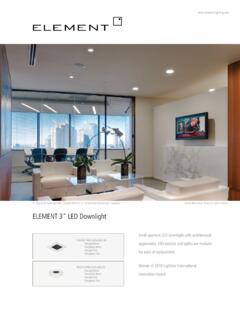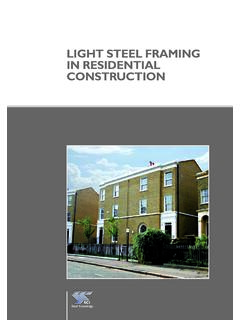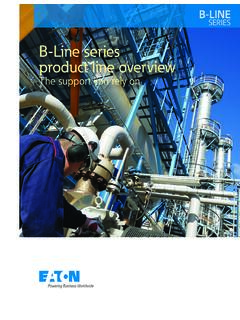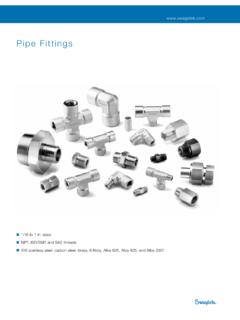Transcription of CONSTRUCTION METHODS MODULAR - Buildoffsite
1 ECONOMICS analysis / facts / BUILDING MAGAZINE Is MODULAR CONSTRUCTION the future for the UK building industry as its supporters have long maintained, or is it a hopeless effort to translate factory techniques into an unsuitable industry? The question has divided opinion since the benefits of MODULAR were hyped up 20 years ago. In the wake of the 1998 Egan report, Rethinking CONSTRUCTION , enthusiasts claimed the quality, speed and cost savings achievable with factory production of MODULAR units offered irresistible benefits to the building industry. The anticipated revolution did not happen, and those who experimented found the benefits did not always materialise.
2 The pattern has all the hallmarks of the Gartner hype cycle for emerging technologies, which shows the way technology is adopted, with the peak of inflated expectations followed by the trough of disillusionment (see figure 1). The 2016 Farmer review put MODULAR in the spotlight again as part of the solution to the building industry s ills. So is MODULAR now climbing Gartner s slope of enlightenment to reach the plateau of productivity ? To find out, this study rehearses the potential benefits of MODULAR CONSTRUCTION and explores the barriers that have limited uptake of prefabrication in the UK including a failure to understand the business model and an overwhelmingly negative public image.
3 It examines where successes have been achieved, where they have not and where the greatest potential for future development CONSTRUCTION is touted as the future of the building industry, but while the sector is rapidly growing in some areas, there are still obstacles to overcome. Alex Hyams of Alinea, Ed McCann of Expedition Engineering and Hugh Ferguson assess the pros and cons of volumetric MODULAR offsite constructionCONSTRUCTION METHODS MODULAR01 / INTRODUCTIONM odular CONSTRUCTION describes substantial elements of a building that are factory-produced and delivered to site for assembly. It comes in several forms the principal focus of this article is volumetric MODULAR Volumetric MODULAR systems prefabrication is used to create complete 3D structural units, usually using steel framing or light -gauge steel sections but also precast concrete, timber or a combination of these.
4 The modules may be fully fitted out in the factory, including services and internal fixtures and fittings. They are then driven to the site and craned into position, with combinations of modules often stacked used to create larger volumetric modules have load-bearing walls. They rely on the wall panels for structural strength, either for vertical load bearing or for diaphragm action to resist lateral volumetric modules are frame + infill , using posts and beams typically formed from hot-rolled steel sections to frame the units. Non-structural infill panels are inserted between the posts to form the walls, providing greater flexibility in room layout than a solid-wall module.
5 Floors and ceilings span to the perimeter of the Panel systems (or flat panel systems) 2D panels are prefabricated, delivered to site and craned into position, then connected to form a structure. Materials are typically precast concrete, timber, cross-laminated timber or structural insulated panels. Finishes and services are usually installed on site after Pods are relatively small prefabricated modules, usually fully fitted out, which may be used in conjunction with another CONSTRUCTION method. Common examples are bathroom or kitchen Hybrid systems may combine volumetric or panelised systems with other precast elements and/or a primary structural frame.
6 Figure 1: Gartner hype cycle, showing a technology s journey to mainstream acceptanceMapleton Crescent, by Vision ModularVISIBILITYTIMEPeak of inflated expectationsModular triggerTrough of disillusionmentSlope of enlightenmentPlateau of productivityWHAT IS MODULAR CONSTRUCTION ?TIDE CONSTRUCTION / VISION MODULAR economics / CONSTRUCTION METHODS / 47 BUILDING MAGAZINE / POTENTIAL BENEFITS Speed Programme savings of up to 50% are possible compared with traditional forms of CONSTRUCTION . Furthermore, the programme can be more predictable than when using conventional METHODS if errors do occur during fabrication, the effect on the overall CONSTRUCTION process can be more easily managed, since repairs are limited to one particular module and can be completed smaller site area is required on site as fewer CONSTRUCTION materials are stored there.
7 With careful management of the delivery and installation of modules, temporary storage can be minimised or removed altogether. Cost savings The repetitive nature of MODULAR CONSTRUCTION , which is tailored to a factory environment, creates lower costs though these savings are not always achieved in practice, as explained in the next section, below. Savings in labour costs are possible, by more efficient use of labour or by avoiding city centre wages. Standardised details can reduce overall design fees and a more predictable CONSTRUCTION programme reduces the risk of increased costs due to delays on shorter CONSTRUCTION programme can also reduce the costs of site management and facilities costs, while producing a faster return on investment, with reduced financing costs.
8 The manufacturer s cost base should be more predictable as there is greater control of the workforce, who are likely to be on more permanent or fixed contracts, than with site-based alternatives where operatives move from site to site looking for better pay and conditions. Transferring from trade-based delivery to a more task-trained operative scenario not only reduces cost but also improves access to labour and can help alleviate some impending CONSTRUCTION skills capacity , safety and wellbeing of staff In the controlled factory environment, risks such as working at height and exposure to bad weather, noise and dust are reduced or eliminated, while other hazards can be better identified and mitigated.
9 Fewer trades and personnel are required in the more dangerous site environment. Also, the workforce in a static factory has longer-term job prospects, extending beyond completion of the current Assembly in a factory can consistently deliver airtight, thermally efficient CONSTRUCTION , with lower running costs. The air gaps between modules in volumetric CONSTRUCTION assist in providing acoustic separation between units. Factory production can deliver more durable CONSTRUCTION , which requires less a controlled factory environment, strict quality assurance procedures can be more easily achieved, resulting in improved quality of CONSTRUCTION .
10 There is a reduced risk of moisture ingress during CONSTRUCTION , and workmanship is not affected by bad weather. Reduced numbers of errors mean fewer snags and fewer defects on handover, and consequently a reduction in the associated costs and CONSTRUCTION offsite means less waste as the controlled conditions enable work to be more precise and there are fewer mistakes, and waste produced in a factory can be more easily recycled. On a residential building, most of the lifetime energy use is due to space heating: the better airtightness and thermal performance obtainable in factory conditions, particularly with volumetric modules, translates into lower energy use and lower running costs for occupants.











